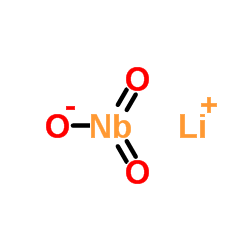Lithium oxido(dioxo)niobium

Lithium oxido(dioxo)niobium structure
|
Common Name | Lithium oxido(dioxo)niobium | ||
|---|---|---|---|---|
| CAS Number | 12031-63-9 | Molecular Weight | 147.846 | |
| Density | 4,659 g/cm3 | Boiling Point | N/A | |
| Molecular Formula | LiNbO3 | Melting Point | 1275°C | |
| MSDS | Chinese USA | Flash Point | N/A | |
| Name | lithium niobate |
|---|---|
| Synonym | More Synonyms |
| Density | 4,659 g/cm3 |
|---|---|
| Melting Point | 1275°C |
| Molecular Formula | LiNbO3 |
| Molecular Weight | 147.846 |
| Exact Mass | 147.907150 |
| PSA | 57.20000 |
| Index of Refraction | 2.3055 (457 nm 160℃) |
| Stability | Stable. Incompatible with strong oxidizing agents. |
|
Section 1: Product Identification Chemical Name:Lithium niobate (99.998%-Nb)PURATREM CAS Registry Number:12031-63-9 Formula:LiNbO3 EINECS Number:234-755-4 Chemical Family:inorganic compound Synonym:Lithium niobium oxide, Niobium lithium oxide.
Section 2: Composition and Information on Ingredients IngredientCAS NumberPercentACGIH (TWA)OSHA (PEL) Title Compound12031-63-9100%no datano data Section 3: Hazards Identification Lithium is toxic to the central nervous system and on repeated ingestion may damage kidneys and act as a Emergency Overview: teratogen Primary Routes of Exposure:Contact with skin and eyes. Dust inhalation. Eye Contact:May cause slight to mild irritation of the eyes. Skin Contact:May cause slight to mild irritation of the skin. Inhalation:May be irritating to the nose, mucous membranes and respiratory tract. Ingestion:Ingestion may lead to dizziness, abdominal cramps, vomiting, bloody diarrhea, weakness, and convulsions. Acute Health Affects:Lithium is toxic to the central nervous system. May be irritating to skin, eyes and respiratory tract. Chronic Health Affects:May cause kidney damage. May be a teratogen. NTP:No IARC:No OSHA:No SECTION 4: First Aid Measures Immediately flush the eyes with copious amounts of water for at least 10-15 minutes. A victim may need Eye Exposure: assistance in keeping their eye lids open. Get immediate medical attention. Wash the affected area with water. Remove contaminated clothes if necessary. Seek medical assistance if Skin Exposure: irritation persists. Remove the victim to fresh air. Closely monitor the victim for signs of respiratory problems, such as difficulty Inhalation: in breathing, coughing, wheezing, or pain. In such cases seek immediate medical assistance. Seek medical attention immediately. Keep the victim calm. Give the victim water (only if conscious). Induce Ingestion: vomiting only if directed by medical personnel. SECTION 5: Fire Fighting Measures Flash Point:not applicable Autoignition Temperature:none Explosion Limits:none Extinguishing Medium:none required If involved in a fire, fire fighters should be equipped with a NIOSH approved positive pressure self-contained Special Fire Fighting Procedures: breathing apparatus and full protective clothing. Hazardous Combustion andNone Decomposion Products: Unusual Fire or Explosion Hazards: No unusual fire or explosion hazards. SECTION 6: Accidental Release Measures Spill and Leak Procedures:Small spills can be mixed with powdered sodium carbonate or ground limestone and swept up. SECTION 7: Handling and Storage Handling and Storage:Store material in a tightly sealed bottle away from moisture. SECTION 8: Exposure Controls and Personal Protection Eye Protection:Always wear approved safety glasses when handling a chemical substance in the laboratory. Skin Protection:Wear appropriate chemical resistant gloves and protective clothing. Ventilation:If possible, handle the material in an efficient fume hood. In the absence of adequate ventilation a respirator should be worn. The use of a respiratory requires a Respirator: Respirator Protection Program to be in compliance with 29 CFR 1910.134. Ventilation:If possible, handle the material in an efficient fume hood. Additional Protection:No additional protection required. SECTION 9: Physical and Chemical Properties Color and Form:white pwdr. Molecular Weight:147.85 Melting Point:no data Boiling Point:no data Vapor Pressure:no data Specific Gravity:no data Odor:none Solubility in Water:insoluble SECTION 10: Stability and Reactivity Stability:air and moisture stable Hazardous Polymerization:no hazardous polymerization Conditions to Avoid:none Incompatibility:none Decomposition Products:none SECTION 11: Toxicological Information RTECS Data:Oral (rat); LD: >8 gm/kg. Carcinogenic Effects:none Mutagenic Effects:none Tetratogenic Effects:none SECTION 12: Ecological Information Ecological Information:No information available SECTION 13: Disposal Considerations Disposal:Dispose of according to local, state and federal regulations. SECTION 14: Transportation Shipping Name (CFR):Non-hazardous Hazard Class (CFR):NA Additional Hazard Class (CFR):NA Packaging Group (CFR):NA UN ID Number (CFR):NA Shipping Name (IATA):Non-hazardous Hazard Class (IATA):NA Additional Hazard Class (IATA):NA Packaging Group (IATA):NA UN ID Number (IATA):NA SECTION 15: Regulatory Information TSCA:Listed in the TSCA inventory. SARA (Title 313):Title compound not listed Second Ingredient:none SECTION 16 - ADDITIONAL INFORMATION N/A |
CHEMICAL IDENTIFICATION
HEALTH HAZARD DATAACUTE TOXICITY DATA
|
| Hazard Codes | Xi |
|---|---|
| Safety Phrases | S22-S24/25 |
| RIDADR | NONH for all modes of transport |
| RTECS | QT9800000 |
|
Legendre and Laguerre polynomial approach for modeling of wave propagation in layered magneto-electro-elastic media.
J. Acoust. Soc. Am. 133(3) , 1415-24, (2013) A numerical method to compute propagation constants and mode shapes of elastic waves in layered piezoelectric-piezomagnetic composites, potentially deposited on a substrate, is described. The basic fe... |
|
|
Upconversion white-light emission in Ho3+/Yb3+/Tm3+ tridoped LiNbO3 single crystal.
Optics Letters 37(17) , 3537-9, (2012) Ho3+/Yb3+/Tm3+ tridoped LiNbO3 single crystal exhibiting intense upconversion white light under 980 nm excitation has been successfully fabricated by the Czochralski method. The tridoped LiNbO3 single... |
|
|
Nearly degenerate wavelength-multiplexed polarization entanglement by cascaded optical nonlinearities in a PPLN ridge waveguide device.
Opt. Express 21(6) , 7841-50, (2013) In this paper we report the generation of wavelength-multiplexed polarization-entangled photon pairs in the 1.5-μm communication wavelength band by using cascaded optical second nonlinearities (sum-fr... |
| Niobium, olatodioxo-, lithium salt (1:1) |
| MFCD00011080 |
| Lithium metaniobatem Lithium niobium oxide Lithium niobium trioxide |
| Lithium niobate |
| LITHIUM METANIOBATE |
| Rubidium columbate |
| niobiumlithiumoxide |
| EINECS 234-755-4 |
| Lithium niobate wafer |
| Lithium niobium oxide |
| niobate,lithium |
| Lithium oxido(dioxo)niobium |
| lithiummethaniobate |

